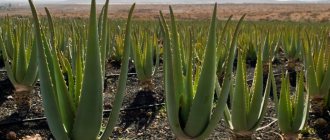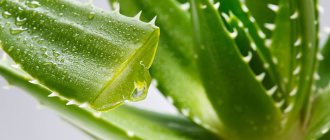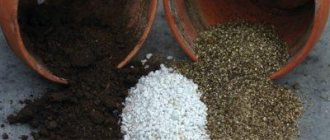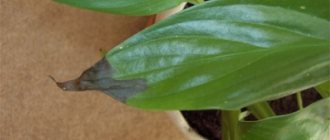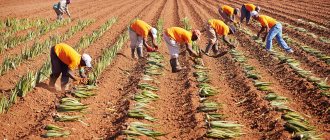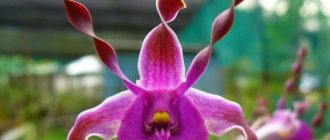How to plant aloe correctly at home
This plant belongs to the category of succulents. Therefore, aloe prefers well-lit window sills and easily tolerates a lack of moisture, as it accumulates it in its leaves with rare watering. If the basic requirements of the culture are met, this plant will not cause any trouble.
Aloe is rightfully considered a home healer.
Note! For its full development, it is important to plant correctly. This procedure includes several main steps. Therefore, it is worth familiarizing yourself with them in advance.
What time of year is it better to plant and is it possible in winter?
It is best to plant aloe, like other indoor plants, in late February - early March. It is during this period that the plant emerges from the state of winter dormancy and biological processes intensify.
If it was not possible to plant during this period, then you can postpone the procedure until the end of summer, namely until July-August. At this time, sap flow in the tissues of the plant increases, so it easily tolerates planting and quickly recovers
Important! Planting aloe in late autumn, as well as at the beginning and middle of winter, is not recommended, since at this time the plant is in the dormant stage and will not be able to fully take root, which means it will die.
What kind of soil is needed for aloe
In nature, this plant can be found in countries with arid climates and soil poor in nutrients. At the same time, aloe feels great in such conditions and grows well. Therefore, it is necessary to prepare soil for it, the composition of which will be as close as possible to its natural habitat.
You can purchase a ready-made substrate at a flower shop, choosing a soil mixture for cacti and succulents. But you can also prepare suitable soil for aloe yourself. The main thing is that the substrate is loose, light and well-drained.
To plant aloe you will need to mix the following components:
- turf - 40%;
- leaf soil - 20%;
- coarse sand – 20%;
- small pebbles - 10%;
- charcoal - 10%.
Important! Peat should not be added to the soil, as it increases acidity, and this has a depressing effect on the roots of the plant.
The soil for aloe should not be nutritious, the main thing is that moisture does not stagnate in it.
In what container is aloe grown: pot sizes
The root system of aloe, like all succulents, is small, but the leaves are fleshy and large, since they contain a supply of moisture and nutrients. Therefore, it is necessary to select not too deep, but wide pots for the plant. When planted in high containers, the plant will constantly turn over.
The diameter of the pot should be selected depending on the age of the seedling
At the initial stage of growth, the width of the planting container should be within 8-9 cm. With subsequent transplants, it can be increased by 2-3 cm.
For your information! You cannot immediately plant aloe in a container that is too large, as the excess soil in the pot will begin to turn sour and cause root rot.
Required soil composition
The first question that arises before planting a plant is what kind of soil is needed for aloe. The first thing you need to pay attention to is the acidity of the soil. A slightly acidic soil or even a soil with neutral acidity is ideal. It is important to provide air access to the roots of the plant. Without this, the flower will not develop and will soon disappear. Suitable as a leavening agent:
Regardless of what type of aloe will grow, the basic composition of the soil will be as follows:
To prepare for planting, soil for aloe is mixed in the following proportions. One part of all other components is added to two parts of turf soil. If we consider a pot of soil in a vertical section, the soil mix will be located as follows.
Experts advise avoiding purchasing ready-made soils, as they contain a large amount of peat. Such soil will not drain moisture well. It will accumulate in it and lead to rotting of the aloe roots.
How to properly plant aloe in a pot
Before you start planting, you need to prepare everything in advance so that everything is at hand during the procedure. For this you will need:
- pot;
- priming;
- drainage;
- settled water at room temperature;
- Activated carbon;
- sharp knife.
How to plant ampelous petunia correctly
When everything is prepared, you can proceed directly to planting aloe. It is important to follow the procedure and strictly adhere to the recommendations.
Landing algorithm:
- Inspect the root of the seedling and, if necessary, remove damaged and rotten areas with a knife.
- Sprinkle the sections with activated carbon.
- Place a 1.5-2 cm layer of drainage on the bottom of the pot.
- Sprinkle it with substrate on top.
- Place the seedling in the center of the pot, carefully straighten the roots so as not to damage them.
- Fill the resulting voids with soil and lightly compact the surface.
- Water the plant generously and place it in a slightly shaded place for rooting.
Note! When planting, the aloe root collar should be at or slightly above the soil surface, which will eliminate the possibility of stem rotting.
As soon as the seedling begins to grow, it must be placed on a sunny windowsill. In the future, it is necessary to water the planted plant as the top layer of soil dries out.
How to grow aloe from a shoot without roots
Sometimes the question arises of how to plant aloe if the shoot is without a root. It is quite possible to grow a plant in this case if you act correctly.
Schisandra chinensis - how to plant correctly
This situation may arise in the following cases:
- the lateral branch had to be disconnected;
- the bush requires rejuvenation;
- The roots of the plant rotted, but the top survived.
Important! Since aloe is a succulent, it is not recommended to root the shoot in water, as it can rot, so it is better to plant it directly in the soil.
Are there any chances of success?
Before planting a cutting without roots, it is necessary to refresh the cut and leave it to dry for 2-3 days in a shaded place. During this time, a kind of film is formed that protects against infection from penetrating the plant tissue and prevents excessive evaporation of moisture.
Rooting of the shoot occurs within 3-4 weeks
In the meantime, it is necessary to prepare special soil for the aloe shoot. In this case, you need to mix turf soil and river sand in a ratio of 1:2. Heat it in the oven for 15 minutes. at a temperature of 100 °C to disinfect.
To plant the shoot, you can use a plastic glass, make drainage holes in it, lay expanded clay on the bottom in a layer of 2 cm, and fill the remaining 2/3 of the volume with the prepared substrate and moisten it. After this, plant the shoot, deepening it into the soil until the first pair of leaves. Then compact the soil at the base and sprinkle the surface with small pebbles. This will strengthen the seedling and prevent it from falling.
For complete rooting, it is necessary to move the container with the cuttings to a bright place with a temperature of 23-25 ° C, and the plant should not be exposed to direct sunlight. Periodically it is necessary to moisten the soil, observing the rule - it is better to underwater than to overwater.
If the entire procedure was carried out correctly, the shoot will take root without any problems. This can be determined by the new leaves that begin to appear at the top.
For your information! A month after rooting, the shoot must be transplanted into suitable soil and pot.
How to grow aloe from a leaf
This method of growing an aloe vera seedling or other type of crop at home is more labor-intensive.
Chinese date - how to plant and care for it correctly
For rooting, it is necessary to use the lower leaves from a plant older than 3 years. They must be fully developed and have good turgor. The leaves need to be cut off at the base with a sharp knife and placed in a shaded, dry place to form a protective film for 2-3 days.
Rooting should be carried out in clean sand, which should be calcined in the oven in advance. For planting, you need to choose wide bowls with drainage holes to drain excess water. It is necessary to fill them with prepared sand and moisten it evenly. The leaves need to be buried 3 cm in the sand, and the container with seedlings should be placed in a warm, bright place with an air temperature of 23-25 °C.
Important! To grow aloe from a leaf, as well as from a shoot, it is not necessary to create a greenhouse effect during rooting, as this leads to rotting.
If all recommendations are followed, after 1.5-2 months small sprouts should appear at the base of the leaves. Throughout this period, the sand in the container must be kept slightly moist.
Leaf propagation requires patience
It is necessary to plant young seedlings in separate containers when their leaves grow to 3-5 cm. In this case, you need to take a full-fledged substrate as for adult plants.
Knowing how to grow aloe from a leaf, you can get a large amount of planting material. This propagation method allows you to preserve all the specific qualities of the mother plant, which cannot be achieved if you germinate seedlings from seeds.
Caring for aloe at home after planting
A planted plant needs quality care. Any mistake by the grower at this stage of growing aloe can be disastrous, since the plant has not yet had time to get stronger. Therefore, attention should be paid to the basic requirements of culture, which cannot be ignored.
Rules of care:
- lighting. Aloe is considered a light-loving plant, so it is necessary to select a southern or eastern window sill for it. But it is necessary to avoid direct sunlight, as it can cause burns on the leaves. In winter, this indoor plant needs additional artificial lighting. The lamps should be placed at a height of 35 cm above the plant;
- content temperature. This succulent feels good at high temperatures. In summer, a flowerpot with a flower can be placed outside. In winter, when aloe is at rest, the favorable temperature is 16 ° C;
- humidity. Aloe is a drought-resistant plant, so the leaves should not be sprayed. The optimal humidity level is 60-65%. Sometimes you can simply wipe the leaves to remove dust;
- transfer. This procedure should be carried out when the succulent pot becomes crowded. In this case, the plant stops actively growing, and the young leaves become significantly smaller. It is recommended to carry out replanting using the transshipment method, without destroying the earthen ball at the roots.
How to feed aloe
This plant does not require high levels of nutrients. For feeding, you should use mineral fertilizers, which can be purchased at the store labeled “for succulents.”
Aloe rarely needs to be fertilized.
Features of fertilizing:
- when planting in a purchased substrate, you need to apply fertilizer for the first time only after six months, and in other cases - after 3 months;
- The dosage indicated in the instructions cannot be exceeded;
- It is necessary to use fertilizers from March to the end of September once a month, and take a break in late autumn and winter;
- Only healthy seedlings can be fed.
Important! You cannot use aloe for medicinal purposes after feeding; in this case, you need to wait 2 months.
How to water correctly so as not to destroy young plants
Aloe does not tolerate waterlogging of the soil. Therefore, you need to water the plant only when necessary when the top layer of soil dries out, avoiding stagnation of moisture. It is also important to periodically loosen the soil in the pot to improve its breathability.
For humidification, it is recommended to use settled water at room temperature. Watering should be carried out at the root so that water does not fall on the leaves. But it is also permissible to sometimes pour water into the pan to saturate the substrate with moisture.
When choosing aloe as a houseplant, planting and caring for it at home will not cause any serious difficulties. Therefore, any gardener can cope with this task, regardless of his experience.
Suitable soil for planting outdoors
With the arrival of spring, it is recommended to take the pot of aloe outside or plant it in open ground. If you decide to plant a flower, then it is important to know some nuances when choosing a place:
In principle, the composition of the soil for aloe is the same as in the pot. It is better to replant directly with the lump of soil in which it grew. If there is not enough sand in the ground, you can add it and then dig up the area for planting a flower. The bottom of the hole should be lined with expanded clay or other drainage. Watering is needed infrequently (how to water aloe correctly?).
Composition when grown in open ground
If the climatic conditions of the region allow, you can plant aloe in open ground. It is necessary to choose a sunny place on a hill so that moisture does not stagnate in the soil.
The composition of the soil should be the same as for growing aloe in a pot. If the soil does not have enough sand, you need to add it and dig up the ground.
To plant, you need to make a hole of the required size in the ground. Expanded clay or other drainage must be placed at the bottom of the hole. Experienced gardeners recommend replanting aloe together with a lump of earth from a pot. This makes it easier for the plant to adapt to new conditions.
Possible problems during landing and immediately after it
Often, planting and propagation of aloe occurs without any difficulties. But sometimes gardeners complain that this succulent does not take root. Therefore, you should find out why this happens.
The most common cause of plant death is excessive soil moisture, which is associated with improper watering. To correct the situation, you need to remove the plant from the pot and clean out the rotten areas and roots with a knife. After this, sprinkle the fresh wounds with charcoal and dry for several days in a dark place.
Then plant in a substrate consisting of sand and turf in equal proportions. The plant should not be watered for the next 2 weeks. If during this time the rotting process does not resume, then the soil in the pot can be slightly moistened. As soon as the plant fully strengthens and begins to grow, it needs to be transplanted into a full-fledged substrate.
Mealybug is a dangerous pest of succulents
Another reason why aloe does not take root may be mealybugs. This pest lays eggs in the roots of the plant. As a result, the emerging larvae feed on the sap of the plant, which prevents rooting. In this case, it is recommended to water the plant with a solution of the drug Aktar (1.4 g per 6 l). After a week, spray the plant and soil in the pot with phytoverm.
Note! Treatments should be carried out until the pest is completely destroyed, alternating medications.
What to do if it doesn’t take root
If, despite all the efforts expended, aloe still cannot fully take root, you need to check whether all recommendations are followed. When planting and growing, everything matters, so even the smallest details should not be ignored.
Most often, the plant cannot fully take root, since the temperature regime during the rooting period is not observed. In this case, it is recommended to repeat the planting, replacing the entire soil. You should also wash the pot well and scald it with boiling water.
Growing aloe, like other succulents, is not difficult; the main thing is to provide the plant with conditions that are as close as possible to its requirements. First of all, this concerns planting, since future development depends on this. Otherwise, even an inexperienced gardener can cope with caring for aloe.
The role of soil
A succulent can not only decorate the interior, but also help in the fight against runny nose, acne and skin aging. The rich vitamin and mineral composition of aloe allows it to be used for the preparation of masks, lotions and ointments. However, all these healing properties will only be effective with proper care and nutrition. If the plant develops safely and receives enough useful substances, it is able to evaporate phytoncides, which disinfect the air in the room and activate the protective functions of the human body. Caring for an indoor succulent is a simple matter; by following simple rules you can get a strong and beautiful plant with a rich chemical composition.

